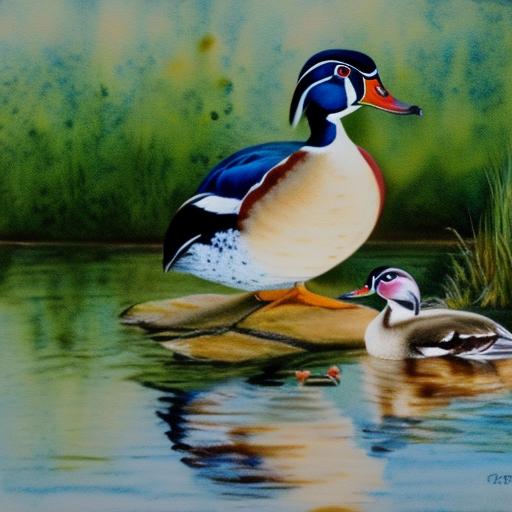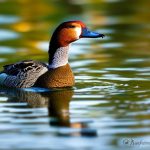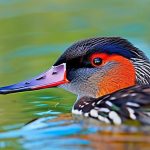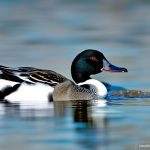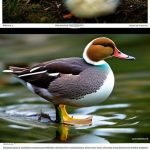Wood ducks, scientifically known as Aix sponsa, are one of the most stunning and colorful waterfowl species found in North America. These beautiful birds are known for their vibrant plumage, with the males sporting iridescent green and purple heads, red eyes, and distinctive white markings, while the females have a more subtle appearance with a grayish-brown plumage and a white teardrop-shaped eye ring. Wood ducks are commonly found in wooded swamps, marshes, and shallow lakes across the eastern United States, as well as parts of Canada and the west coast. They are highly adaptable and can also be found in man-made habitats such as flooded timber, beaver ponds, and reservoirs.
Wood ducks are unique among waterfowl in their nesting habits, as they are cavity nesters, meaning they seek out natural tree cavities or man-made nest boxes to lay their eggs. This behavior sets them apart from other duck species that typically build their nests on the ground. The wood duck population faced a significant decline in the late 19th and early 20th centuries due to habitat loss and overhunting. However, thanks to conservation efforts and the establishment of nest box programs, their numbers have rebounded, and they are now a common sight in wetland habitats across their range.
Key Takeaways
- Wood ducks are colorful and unique waterfowl species found in North America, known for their stunning plumage and distinctive nesting habits.
- Wood ducks prefer to nest in tree cavities near water bodies, and the female selects the nesting site and builds the nest using down feathers.
- Courtship and mating rituals of wood ducks involve elaborate displays by the males to attract females, including head bobbing and whistling calls.
- After the female wood duck lays her eggs, she incubates them for about a month before they hatch, and then leads the ducklings to water within a day.
- Environmental factors such as habitat loss, pollution, and predation can impact wood duck breeding, making conservation efforts crucial for their survival.
Nesting Behavior of Wood Ducks
Wood ducks are known for their unique nesting behavior, which sets them apart from other duck species. Unlike ground-nesting ducks, wood ducks are cavity nesters, meaning they seek out natural tree cavities or man-made nest boxes to lay their eggs. This behavior is an adaptation to their preferred habitat of wooded swamps and marshes, where suitable nesting sites are limited. The female wood duck will often select a nesting site near water, as the ducklings will need to make their way to the water shortly after hatching.
The female wood duck will line the nest cavity with down feathers plucked from her breast to provide insulation and protection for the eggs. She will typically lay around 10-15 eggs over a period of several days, with one egg laid per day. Once all the eggs have been laid, the female will begin incubating them, leaving the nest only briefly each day to feed. The incubation period lasts for about 28-30 days, during which time the female diligently tends to her eggs, turning them regularly to ensure even heat distribution and humidity levels. Once the eggs hatch, the female will lead her ducklings to the water, where they will begin their journey to independence.
Courtship and Mating Rituals of Wood Ducks
Wood ducks are known for their elaborate courtship displays and mating rituals, which are a sight to behold. The courtship displays typically begin in late winter or early spring when the males arrive at the breeding grounds and begin to establish territories. The males will engage in a variety of displays to attract females, including head bobbing, wing flapping, and vocalizations. They will also perform aerial displays, flying high into the air before descending in a series of swoops and dives.
Once a female has been attracted to a male’s territory, the pair will engage in a series of courtship behaviors, including preening each other’s feathers and engaging in mutual head bobbing. The male will also perform a “bridling” display, where he stretches his neck forward and raises his crest while emitting a soft whistle. If the female is receptive, she will crouch low to the ground as the male mounts her for copulation.
After mating has occurred, the female will begin searching for a suitable nesting site while the male remains nearby to defend his territory from rival males. The courtship and mating rituals of wood ducks are not only fascinating to observe but also play a crucial role in ensuring successful reproduction and the continuation of the species.
Incubation and Hatching of Wood Duck Eggs
Once the female wood duck has laid all her eggs in the chosen nesting cavity, she begins the crucial process of incubation. The incubation period for wood duck eggs typically lasts for about 28-30 days, during which time the female diligently tends to her eggs, turning them regularly to ensure even heat distribution and humidity levels. Incubation is a critical stage in the reproductive cycle of wood ducks, as it is essential for the development and hatching of healthy ducklings.
During incubation, the female wood duck will leave the nest only briefly each day to feed, relying on her well-hidden nesting site to keep her eggs safe from predators. She will also use her down feathers to line the nest cavity, providing insulation and protection for the developing embryos. As the incubation period progresses, the female becomes increasingly vigilant, listening for any signs of danger and adjusting her position on the nest to maintain optimal conditions for the eggs.
After nearly a month of careful incubation, the eggs begin to hatch, signaling the start of an exciting new chapter in the wood duck’s reproductive journey. The hatching process can take several hours, with the ducklings using their egg tooth—a small projection on their bill—to break through the shell. Once hatched, the ducklings are ready to embark on their journey to the water under the watchful eye of their mother.
Parental Care and Rearing of Wood Duck Ducklings
After successfully hatching her brood of ducklings, the female wood duck assumes the role of primary caregiver, leading her offspring from the nest to the safety of the water. The journey from nest to water can be perilous for young ducklings, as they must navigate obstacles such as fallen branches and predators lurking in wait. Once at the water’s edge, the mother encourages her ducklings to take their first swim, teaching them essential skills such as diving for food and evading predators.
The mother wood duck is highly protective of her brood, keeping a close watch over them as they explore their new aquatic environment. She provides guidance and protection as they learn to forage for food and develop their swimming abilities. The ducklings rely on their mother for warmth and protection during their early days, huddling close to her for safety.
As the ducklings grow and gain independence, they begin to venture further from their mother’s side, exploring their surroundings and honing their survival skills. The mother continues to provide guidance and protection as they navigate the challenges of life in their wetland habitat. The parental care and rearing of wood duck ducklings are essential for their survival and successful transition to adulthood.
Environmental Factors Affecting Wood Duck Breeding
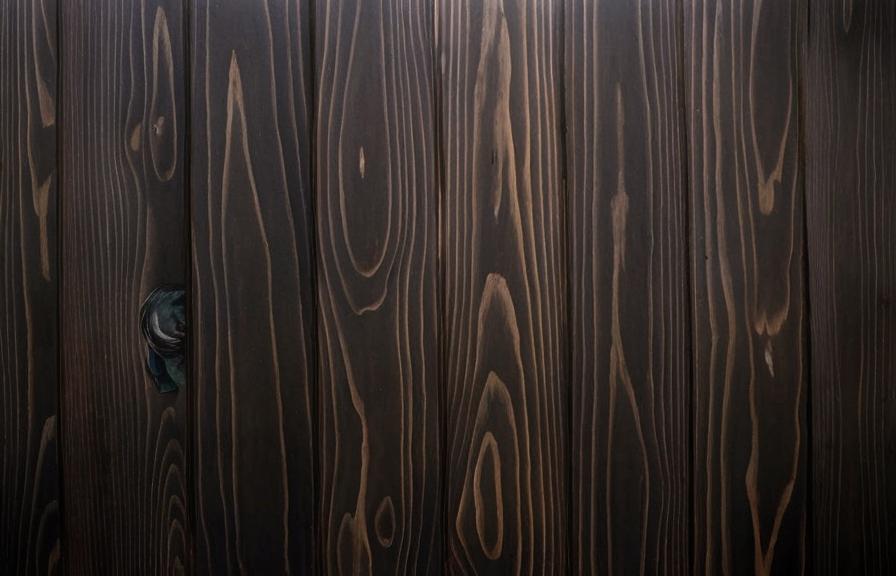
The breeding success of wood ducks is influenced by a variety of environmental factors that can impact nesting habitat quality and reproductive outcomes. One critical factor is the availability of suitable nesting cavities, as wood ducks rely on natural tree cavities or man-made nest boxes for breeding. Loss of mature trees with suitable cavities due to logging or urban development can limit nesting opportunities for wood ducks.
Water quality and availability also play a significant role in wood duck breeding success. Wetland habitats provide essential resources for wood ducks, including food sources and nesting sites. Pollution or habitat degradation can negatively impact water quality and availability, affecting the ability of wood ducks to successfully reproduce.
Predation is another environmental factor that can influence wood duck breeding success. Nest predation by raccoons, snakes, and other predators can significantly impact nesting success rates. Conservation efforts aimed at reducing predation pressure through predator management or nest box design modifications can help improve breeding outcomes for wood ducks.
Conservation Efforts for Wood Duck Breeding Habitats
Conservation efforts aimed at protecting and enhancing breeding habitats are crucial for ensuring the continued success of wood duck populations. One key conservation strategy is the establishment of nest box programs, which provide artificial nesting sites for wood ducks in areas where natural cavities are limited. These programs have been highly successful in increasing nesting opportunities for wood ducks and boosting reproductive success rates.
Wetland restoration projects also play a vital role in supporting wood duck breeding habitats. By restoring degraded wetland habitats and improving water quality, conservationists can create more favorable conditions for wood ducks to thrive. These efforts benefit not only wood ducks but also a wide range of other wildlife species that depend on healthy wetland ecosystems.
Habitat protection is another critical component of conservation efforts for wood duck breeding habitats. By conserving key wetland areas and maintaining suitable nesting sites, conservation organizations can help ensure that wood ducks have access to the resources they need to successfully reproduce.
In conclusion, wood ducks are fascinating waterfowl with unique nesting behaviors and elaborate courtship rituals. Their reproductive success is influenced by a variety of environmental factors, making conservation efforts essential for ensuring their continued survival. By protecting and enhancing breeding habitats through nest box programs, wetland restoration projects, and habitat protection initiatives, we can help secure a bright future for these stunning birds in North America’s wetland ecosystems.
If you’re interested in learning more about the breeding habits of wood ducks, you might also want to check out this informative article on what to feed ducks. Understanding the dietary needs of ducks is crucial for their overall health and reproductive success. By providing the right nutrition, you can support their breeding habits and ensure the well-being of these beautiful birds.
FAQs
What are the breeding habits of wood ducks?
Wood ducks typically breed in the spring and early summer, with nesting occurring from March to July. They prefer to nest in tree cavities near water, such as in hollowed-out trees or in nest boxes.
How many eggs do wood ducks lay?
A female wood duck can lay anywhere from 7 to 15 eggs in a single clutch, with an average of around 10 eggs per clutch.
How long does it take for wood duck eggs to hatch?
Wood duck eggs have an incubation period of about 28 to 37 days, with the female being the primary incubator of the eggs.
What is the role of the male wood duck in breeding?
The male wood duck plays a role in protecting the female and the nesting site, as well as in defending the territory from other males. After the eggs hatch, the male will also help lead the ducklings to water and provide protection.
At what age do wood ducks start breeding?
Wood ducks typically reach breeding age at around 1 year old, although some may not breed until they are 2 years old.
Meet Walter, the feathered-friend fanatic of Florida! Nestled in the sunshine state, Walter struts through life with his feathered companions, clucking his way to happiness. With a coop that’s fancier than a five-star hotel, he’s the Don Juan of the chicken world. When he’s not teaching his hens to do the cha-cha, you’ll find him in a heated debate with his prized rooster, Sir Clucks-a-Lot. Walter’s poultry passion is no yolk; he’s the sunny-side-up guy you never knew you needed in your flock of friends!

